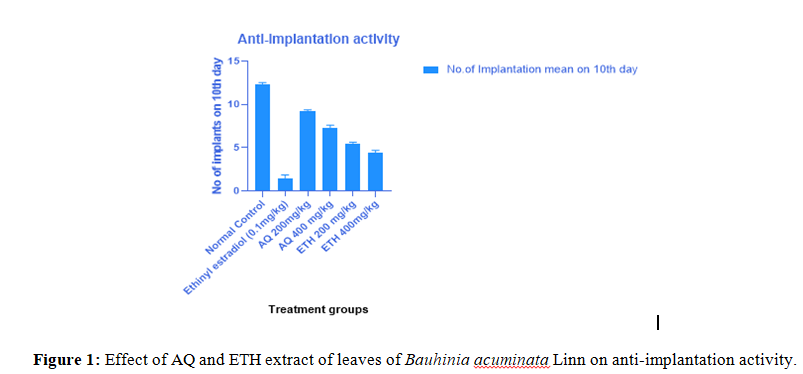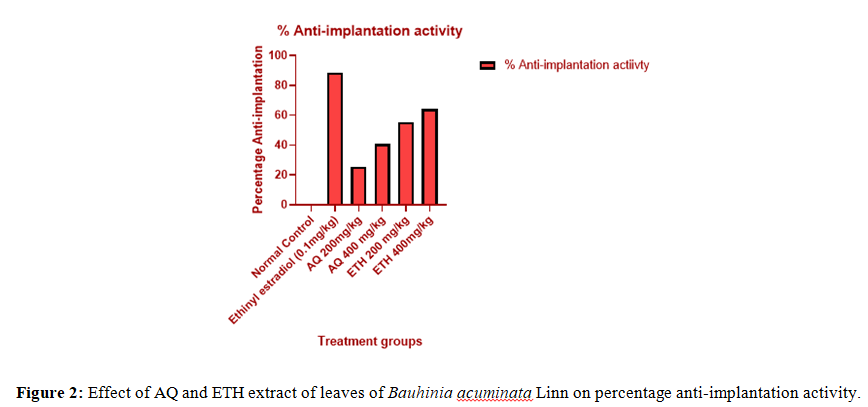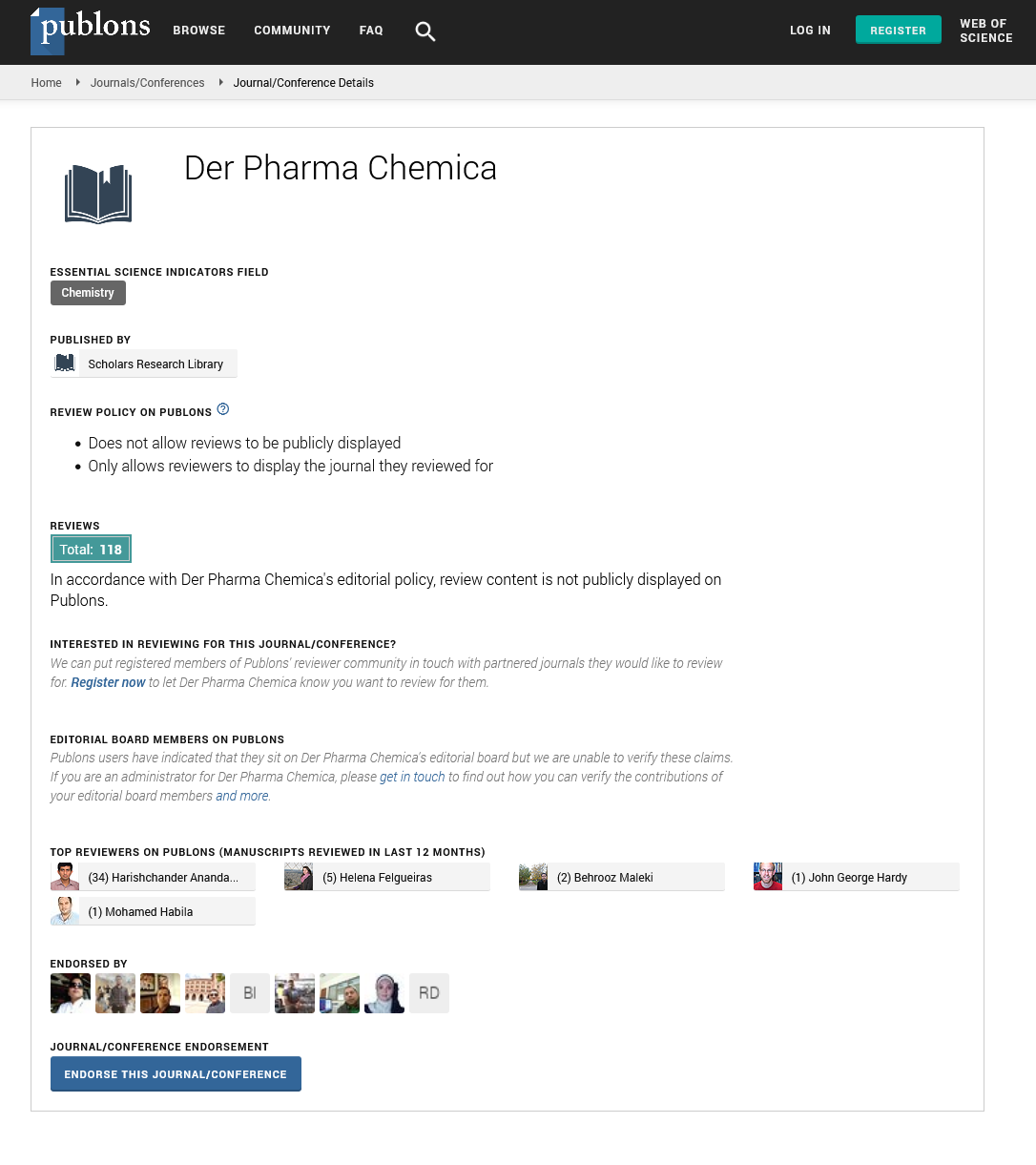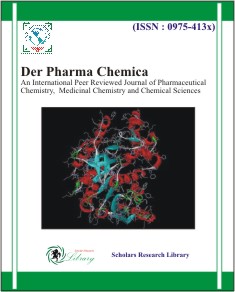Research Article - Der Pharma Chemica ( 2024) Volume 16, Issue 6
Anti-implantation Activity of the Leaf Extract of Bauhinia acuminata Linn
Mohsin J. Jamadar1,2*, Preeti Khulbe2 and Shrinivas K. Mohite32Department of Pharmacy, Suresh Gyan Vihar University, Mahal, Jagatpura, Jaipur, Rajasthan, India
3Department of Pharmacy, Rajarambapu College of Pharmacy, Kasegaon, Taluka Walwa, Sangli, Maharashtra, India
Mohsin J. Jamadar, Department of Pharmacy, Appasaheb Birnale College of Pharmacy, Sangli, India, Email: mohsinjamadar999@gmail.com
Received: 28-Oct-2024, Manuscript No. DPC-23-98966; Editor assigned: 31-Oct-2024, Pre QC No. DPC-23-98966 (PQ); Reviewed: 14-Nov-2024, QC No. DPC-23-98966; Revised: 01-Dec-2024, Manuscript No. DPC-23-98966 (R); Published: 29-Dec-2024, DOI: 10.4172/0975-413X.16.6.558-561
Abstract
Bauhinia acuminata Linn or its local name “Dwarf White Orchid”, “TapakKuda” or “Safed Kachnar” belong to family Caesalpiniaceae is a recent medicinal plant discovered which has been employed by the folks in treating of different types of ailment such as this plant is used to treat acute and chronic pain, skin ailments, cancer, diabetes, throat infections and asthma. As there were no scientific reports on use of Bauhinia acuminata for anti-fertility activity, the present study was designed to evaluate Anti-fertility potential of aqueous and alcoholic extracts of Bauhinia acuminata Linn. Acute toxicity was carried out as per OECD guideline 423 was found safe up to of 2000 mg/kg. Anti-implantation activity of ethanolic extract of Bauhinia acuminata Linn. At doses of 200 mg/kg and 400 mg/kg, orally. Standard Ethinyl estradiol (1 mg/rat per day) was used. Among the two extracts tested at two different doses, the ethanolic extract of Bauhinia acuminata Linn. At 400 mg/kg was found to exhibit anti-fertility activity may be due to rich presence of glycoside, flavonoids, saponins and phenolic compound.Keywords
Anti-fertility; Anti-implantation; Bauhinia acuminata Linn; Aqueous extract; Ethanolic extract; Leaves; Rats
Introduction
There is a growing movement of self-determined women, to regain ancient knowledge about botanical herbs once widely used for the control of pregnancy. This knowledge was once widespread; perhaps even global in nature was largely wiped out in influence of Western culture. In this direction we have aimed to identify a potent anti-fertility agent with minimum side effects from an herbal source that could serve as an alternative remedy for available synthetic medicine and to formulate it into a suitable contraceptive formulation. To lead a healthy life and to get rid of diseases, herbs are being used since ancient time as Ayurvedic practice in India. In Ayurveda, the herbal substances (dravya), their potential energy and qualities (guna) and their ultimate action within the system (karma) are regarded as an inseparable biochemical combination. Each and every dravya has its own guna and karma, by which the dravya is utilized for remedial purposes. While using plant derived drugs thorough knowledge of Dravya-guna-vigyan is essential. The innate and specific property of a dravya is known as pravhav and all the herbs have their own exclusive prabhav [1].
Anti-fertility agents are the agents, which prevents fertility by interfering with various normal reproductive mechanisms, in both males and females. Development of newer methods/agents for fertility control and research in this direction are imperative particularly the developing nations. If an ideal contraceptive were available, that contraceptive would be 100% effective, safe and easy to use; its effect would be reversible. It should be aesthetically and personally acceptable in a variety of social, political and religious setting. It would be suitable culturally in terms of local attitudes concerning sexuality, reproduction; menstruation and the roles and responsibilities of men and women and it would be applicable in terms of the health status of widely differing populations. It would be affordable, readily available and legal. Finally, it would be appropriate for use at all stages of reproduction. A verity of synthetic contraceptive agents is available in the market, but these contraceptives having side effects. Thus, there is a need to replace these drugs by safe and effective contraceptive agents such as plant based contraceptive agents. Many of our ancestors used the plants or plants extracts as anti-fertility agents without any side effects and toxic effects. So in resent research there was much attention has been given to screen plant based contraceptive agents. With all these consequences the present study was aimed to evaluate Bauhinia acuminata Linn. For possible contraceptive property. Bauhinia acuminata Linn is a species of flowering shrub native to tropical South-Eastern Asia. The bark, flower and root of the Bauhinia acuminata Linn are used for various skin diseases, worms, tumors and diabetes. The bark and leaves of Bauhinia acuminata Linn is used to treat biliousness is a remedy recommended by the Indian Vaiydas. In Malaysia and Indonesia, the plant is used in the treatment of common cold and cough. While in India the leaves and bark of this plant are used for treating asthma. Moreover, the leaves of Bauhinia acuminata Linn is used to treat bladder stone, venereal diseases, leprosy, asthma and digestive diseases, though different part of this plant were reported to possess good medicinal properties. Different part of this plant such as bark, leaves, stem, flowers and roots have been used in traditional medicine. Leaves were used externally and internally in skin disease scabies and ringworm. Hot decoction preferred to quinine for its tonic properties. Paste of leaves and calcium hydroxide applied to abscesses for quick opening and clearing of pus. The paste of leaves was externally applied to wounds, sores, itch, cuteanous disease, bone fracture, fever, ringworm, skin disease, throat infection and to cure sore eyes. The leaves and roots were ingredient of many popular herbal liver tonic and medicines for liver disorders. People use it also for the treatment of insect bites, snake bite, scorpion sting, constipation, oedema, fever, inflammation, rheumatism. It roots, leaves, flowers and seeds were used as laxative and purgative. The plant was also used as febrifuge, vermifuge, anticonvulsant and against chicken pox, guinea worm and black quarter. To the best of our knowledge, no study on the Bauhinia acuminata Linn. The fertility regulation has been reported till date. Based on this evidence, we investigated the effect of the hydroal-coholic leaves extract of Bauhinia acuminata Linn. On fertility in female rats. The aim of the present study is to evaluate anti-implantation activity of aqueous and ethanol extract of Bauhinia acuminata Linn. In Female Albino rats [2].
Materials and Methods
Plant material and extraction
Collection and preparation of plant material: The fresh leaves of Bauhinia acuminata Linn are used in the study, the plants are collected at the flowering stage (In the month: August -November) from the botanical department of Shivaji University, Kolhapur, Maharashtra State-India respectively and authenticated by botanical survey of India, Pune Maharashtra.
Extraction process: The leaves of Bauhinia acuminata Linn at 26 ± 2°C, the dried plant material (500 g) each was finely powdered. It was then successive solvent extraction by hot percolation method (Soxhlet extraction) with different solvents of increasing polarity, starting with a highly non-polar solvent viz., petroleum ether (60°C-80°C), chloroform, ethyl acetate, followed by ethanol. The cold maceration was used to prepare AQ extract.
Acute toxicity study: The acute toxicity study was carried on female Albino rats of Wistar strain as per the guidelines No: 423 given by the organization for economic co-operations and development, Paris.
Experimental animals: All experiments were performed on in-bred adult, cyclic virgin female albino rats (weighing 150 gm-200 gm body weight). All the rats were bred in a standard animal house of our college. The rats were housed in polypropylene cages and maintained under environmentally controlled room provided with a 12:12 hrs light and dark cycle for each 24 hrs periods at temperature of approximately 25°C. They were feed on a pellets and tap water [3-5].
Experimental method
Study on anti- implantation activity: The anti-implantation activity was determined according to the method of. Thirty-six mature female’s colony bred Wistar albino rats were divided into six groups (6 female rats per group). One group was used as a control and the other two groups are used as a test group. Female rat of proestrous phase were kept with males with proven fertility in ratio of 2:1. The female rats were examined in the following morning for evidence of copulation the vaginal smear was examined for thick clumps of spermatozoa. The day on which the spermatozoa were found in the smear was considered the first day of pregnancy (Day 1). A 200 mg/kg of body weight and 400 mg per kg of body weight of the extract was administrated intra-gastrically for 10 days from day 1 to day 10 of pregnancy for the test group and same volume of vehicle for the control group. On day 11, all groups of rats were laparotomized under light ether anesthesia to determine the number of implantation sites in the horns of the uteri. The presence of significant difference in the mean number of implantation sites between the extract and the control was taken as a positive response (Figures 1 and 2) (Table 1). The animals divided into six groups of six animals each. The various groups were treated as follows:
Group I: Served as control and received 0.5 ml distilled water orally for 10 days.
Group II: Served as standard Ethinyl estradiol (0.1 mg/kg) s/c once daily for 10 days.
Group III: Received 200 mg/kg AQ extracts of leaves of Bauhinia acuminata Linn for one to ten days of pregnancy
Group IV: Received 400 mg/kg AQ extracts of leaves of Bauhinia acuminata Linn for one to ten days of pregnancy
Group V: Received 200 mg/kg ETH extracts of leaves of Bauhinia acuminata Linn for one to ten days of pregnancy
Group VI: Received 400 mg/kg ETH extracts of leaves of Bauhinia acuminata Linn for one to ten days of pregnancy
| Treatment | Days of administration | No. of rats without implantations 10th days | No. of Implantation Mean On 10th days | % Anti-implantation activity |
|---|---|---|---|---|
| Vehicle (Normal) control (Dist. water) | 1 to 10 days | 0 | 12.36 ± 0.17 | --- |
| Ethinyl estradiol (0.1 mg/rat per day) | 1 to 10 days | 0 | 1.44 ± 0.42*** | 88.35% |
| AQ 200 mg/kg | 1 to 10 days | 2 | 9.23 ± 0.16* | 25.32% |
| AQ 400 mg/kg | 1 to 10 days | 1 | 7.31 ± 0.31* | 40.86% |
| Eth 200 mg/kg | 1 to 10 days | 1 | 5.51 ± 0.14* | 55.42% |
| Eth 400 mg/kg | 1 to 10 days | 0 | 4.42 ± 0.28** | 64.23% |
Table 1: Anti-implantation activity of aqueous and ethanolic extract of leaves of Bauhinia acuminata Linn.
The percentages of anti-implantation activity were calculated using the formula given:

Results
Anti-implantation activity
The anti-implantation activity is expressed as the percentage (%) decrease(reduction) in the no. of implantations in the uteri on day-10 of pregnancy and the no. of resorbed implants from the existing no. of implants will be recorded on day-18 for evaluating the early abortifacient activity. The ETH ext. have offered significant and dependent anti-implantation and early abortifacient activity by reducing the no. of implantation sites and showed significant resorption of the existing implants compared with vehicle control. Standard drug (0.1 mg/kg s/c) Ethinyl estradiol inhibited pregnancy in rats with mean number of implantations 1.44 ± 0.42, the percentage pre-implantation loss was 88.35 %(***p<0.001). The present findings showed that aqueous extracts of leaves of Bauhinia acuminata Linn. (200 and 400 mg/kg) have shown significant reduction (*p<0.05) in number of implants 25.32% and 40.86 % respectively when compared to control group and ethanolic extracts of leaves of Bauhinia acuminata Linn. At 200 mg/kg have shown significant reduction in number of implants (*p<0.05) by 55.42% and at 400 mg/kg have significant anti-implantation loss (**p<0.01) in number of implants by 64.23% as compared to control group [6,7].
Discussion
One of the most critical problems facing a developing country like India is its geometrical increase in human population. About 90% of the world’s contraceptive users are women. This gender-based usage has occurred due to the emphasis of family planning programs and contraception research [8]. Condoms, vasectomy and withdrawal are the only male contraception devices available with less assurance for men. It has, therefore, become necessary to use biologically active botanical substances or fertility-regulating agents of plant origin which are eco-friendly in approach and interfere with the natural patterns of reproduction. Nearly 80% of the world population relies on traditional medicines for primary health care, most of which involve use of plant extracts. Implantation of fetus in uterus is the most important step to give birth a litter [9,10].
Conclusion
The present research was carried out to evaluate the anti-implantation of the ethanolic extract of leaves of Bauhinia acuminata Linn. The anti-implantation activity was done to access the anti-fertility activity potentials of the ethanolic extract of leaves of Bauhinia acuminata Linn. and revealed that the extract has anti-implantation activity as it successfully inhibited the formation of implants in the animals treated with the extract.
The presence of chemical constituents in ethanolic extracts of leaves of Bauhinia acuminata Linn. Glycosides, flavonoids, saponins and phenolic compounds these constituents may be responsible for its anti-implantation activity. The present experimental findings suggest that, ethanolic extracts of leaves of Bauhinia acuminata Linn. Has anti-implantation activity, hence responsible for its anti-fertility activity. Further studies are going on laboratory, to find out the active principles and the exact mechanism of action.
Acknowledgment
This investigation is financially supported by the department of pharmacology, Appasaheb Birnale college of pharmacy, Sangli, Maharashtra, Mumbai, India.
References
- Padgaonkar AV, Suryavanshi SV, Londhe VY, et al. Biomed. Pharmacother. 2018; 97: p. 60-66.
- Yadava RN, Reddy VM. Nat Prod Res. 2003; 17(3): p. 165-169.
[Crossref] [Google Scholar] [PubMed]
- Pandey S. Asian Pac J Trop Dis. 2015; 5(2): p. 123-129.
- Chakraborty S, Bala NN, Das S. Res J Pharm Tech. 2023; 16(5): p. 2177-2181.
- Gnanamoorthy G, Ramar K, Ali D, et al. Optl Mat. 2022; 123: p. 111945.
- Gunalan G, Saraswathy A, Vijayalakshmi K. Asian Pac J Trop Dis. 2012; 2: p. 21-25.
- Mukundan D, Mohankumar R, Vasanthakumari R. Mater Today. 2015; 2(9): p. 4309-4316.
- Rajkapoor B, Murugesh N, Rama Krishna D. Nat Prod Res. 2009; 23(15): P. 1384-1389.
[Crossref] [Google Scholar] [PubMed]
- Fang EF, Wong JH, Bah CS, et al. Biochem Biophys Res Commun. 2010; 396(4): p. 806-811.
[Crossref] [Google Scholar] [PubMed]
- Gul H, Awais M, Saddick S, et al. Saudi J Biol Sci. 2021; 28(1): p. 247-254.
[Crossref] [Google Scholar] [PubMed]





